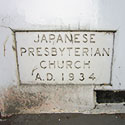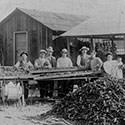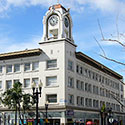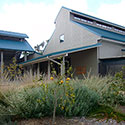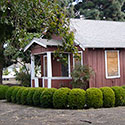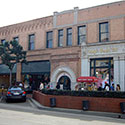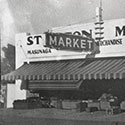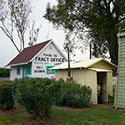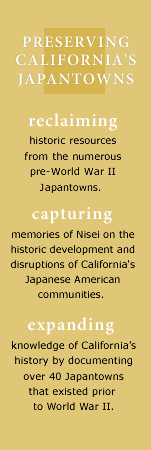 |
Orange CountyThe orange groves that called so many to Southern California in the late 19th century also drew Japanese immigrants to Orange County. Issei farm workers soon moved into the area’s growing celery fields, and began to lease land and cultivate new crops including tomatoes, beans, strawberries and chili peppers. By 1942, Japanese immigrants and their children had helped to make Orange County’s 795 square miles one of the nation’s richest agricultural areas. A handful of Japanese immigrants ran businesses in urban centers, but most of the county’s nearly 2,000 Nikkei residents were spread across a predominantly rural landscape, with small clusters around community institutions such as language schools and churches. Preserving California’s Japantowns' historic resource survey took this dispersed pattern of Nikkei life into account as we searched out the scattered remnants of Nikkei history in today’s highly developed Orange County. ›› CLICK TO ENLARGE.
PROFILES
| ||||

Religious services, community events, athletic clubs, and Japanese language classes sponsored by Nikkei churches provided critical social connections for the dispersed Orange County community. The earliest churches were Anaheim Japanese Free Methodist Church, the Buddhist Church in Talbert and Wintersburg Presbyterian Mission in what is now Huntington Beach. Begun in 1904, the Wintersburg Mission building and a small minister's home were dedicated in 1910 through funds and labor provided by local Japanese immigrants and "some good American friends." In 1930, the Mission became the Wintersburg Presbyterian Church and plans were formed to build a new church structure. The congregation used this building until 1966.
Among the very few substantial Nikkei resources left in all of Orange County, the Wintersburg Japanese Presbyterian Church complex is unusual for its range of structures demonstrating the growth of a Japanese Christian church. The complex retains the original 1909-1910 Mission building, a rectory dating to 1910, the larger 1934 church built, and the home of church benefactor, C.M. Furuta. At the time of our 2007 Preserving California’s Japantowns survey, the property was fenced off and potentially threatened by development.

This 1912 home next to the Wintersburg Presbyterian Church belonged to the family of C. Mitsuji and Yukiko Furuta. C.M. Furuta began life in the United States as a laborer, but became a prominent rancher, goldfish farmer, and church benefactor. Mr. Furuta was involved in the Japanese Presbyterian Mission since its founding, and donated the land on which the 1934 church building was constructed. Early photographs show that the Furuta property included a tennis court and swing used by the congregation.

Garden Grove, Anaheim and the Talbert area were centers for chili pepper cultivation. As Japanese immigrant farmers developed more effective methods for drying chili pods, Orange County became the premier chili-producing area in the United States. Chilies were dried in the late fall and winter, their sweet, peppery scent would fill the air for miles. By the 1920s, Nikkei farmers were responsible for half of all chili production. The Japanese Chili Association of Garden Grove ran the County's largest drying operation, with ten acres filled with warehouses and drying sheds. Wartime incarceration of Orange County's Nikkei farmers led to a seventy-five percent drop in chili production from 1941 to 1942.

The only attorney listed in 1940 Japanese American directories for Orange County, Stephen Kosaku Tamura opened his first law office in this building in 1938. A native of Huntington Beach, Tamura studied law at UC Berkeley and returned to Orange County to practice his profession in Santa Ana up until WWII internment, first in this structure and then at another location in downtown Santa Ana. Tamura was incarcerated in Poston with his family and later served in the all-Nisei 442nd Regimental Combat Team. In 1961, he was appointed to the Orange County Superior Court and later was the first Asian American to sit on the California Court of Appeal.

In 1915, local offices of the Japanese Association were housed in this imposing building in downtown Santa Ana, the county seat. Registering their dismay at the growth of the county's Japanese population, the Orange County Farm Bureau, which was also located in Santa Ana, declared "the Japanese to be an unassimilable element" in 1922. Not surprisingly, early Nikkei farmers established their own agricultural associations, such as the Southern California Japanese Farm Association and the Seal Beach Farmers Association. By 1940, however, Orange County's Japanese American farmers were reportedly active members of the County Farm Bureau.

Founded in 1922 near a railroad crossing in Stanton. Masunaga and Takayama General Store was the largest Nikkei-owned grocery in Orange County before World War II. The building above shows the structure after it was remodeled just prior to the onset of WWII.

Professor Art Hansen and staff at the California State University Fullerton's Center for Oral and Public History were critical to Preserving California's Japantowns research. The information presented here draws heavily from their archives and from the inaugural exhibit of CSUF's Agricultural & Nikkei History Museum, "Sowing Dreams, Cultivating Lives: Nikkei Farmers in Pre-World War II Orange County," curated by Stephanie George. A 1985 historic building survey by Phil Brigandi (now Orange County Archivist) for the Orange County Japanese American Council was also extremely helpful.

The central structure depicted above is a historic bathhouse, complete with galvanized soaking tub and fireplace, that served as an ofuro on the Oda Ranch in Talbert (now part of Fountain Valley). S.H. Oda converted the building at left in 1936 from its original use as the Talbert Bros. Real Estate Office to a barbershop. Oda cut hair in this structure for four years until he erected a new building large enough to house a pool hall along with his barbershop. Both of these structures were moved by the Fountain Valley Historical Society from their original location at the corner of Bushard and Talbert to Fountain Valley's Heritage Park at Slater and Brookhurst Streets.
